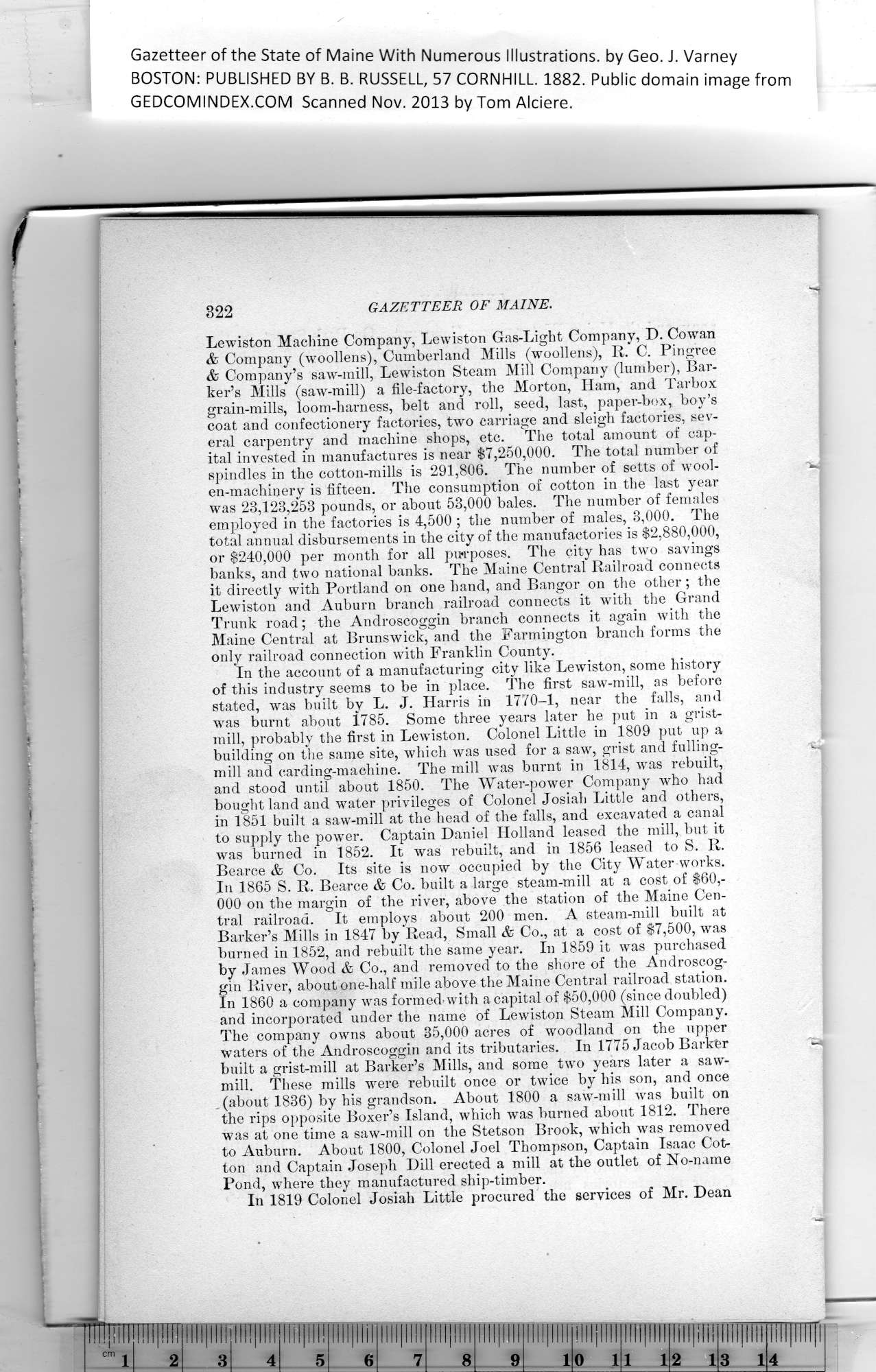|
Gazetteer of the State of Maine With Numerous Illustrations, by Geo J Varney
BOSTON: PUBLISHED BY B. B. RUSSELL, 57 CORNHILL. 1882. Public domain image from
322 GAZETTEER OF MAINE.
Lewiston Machine Company, Lewiston Gas-Light Company, D. Cowan
& Company (woollens), Cumberland Mills (woollens), R. C. Pingree
& Company’s saw-mill, Lewiston Steam Mill Company (lumber), Bar-
ker’s Mills (saw-mill) a file-factory, the Morton, Ham, and Tarbox
grain-mills, loom-harness, belt and roll, seed, last, paper-box, boy’s
coat and confectionery factories, two carriage and sleigh factories, sev-
eral carpentry and machine shops, etc. The total amount of cap-
ital invested in manufactures is near $7,250,000. The total number of
spindles in the eotton-mills is 291,806. The number of setts of wool- t*,
en-machinery is fifteen. The consumption of cotton in the last year
was 23,123,253 pounds, or about 53,000 bales. The number of females
employed in the factories is 4,500 ; the number of males, 3,000. The
total annual disbursements in the city of the manufactories is $2,880,000,
or $240,000 per month for all purposes. The city has two savings
banks, and two national banks. The Maine Central Railroad connects
it directly with Portland on one band, and Bangor on the other; the
Lewiston and Auburn branch railroad connects it with the Grand
Trunk road; the Androscoggin branch connects it again with the
Maine Central at Brunswick, and the Farmington branch forms the
only railroad connection with Franklin County.
In the account of a manufacturing city like Lewiston, some history
of this industry seems to be in place. The first saw-mill, as before
stated, was built by L. J. Harris in 1770-1, near the falls, and
was burnt about 1785. Some three years later he put in a grist-
mill, probably the first in Lewiston. Colonel Little in 1809 put up a
building on the same site, which was used for a saw, grist and fulling-
mill and carding-machine. The mill was burnt in 1814, was rebuilt,
and stood until about 1850. The Water-power Company who had
bought land and water privileges of Colonel Josiah Little and others,
in 1851 built a saw-mill at the head of the falls, and excavated a canal
to supply the power. Captain Daniel Holland leased the mill, but it
was burned in 1852. It was rebuilt, and in 1856 leased to S. R.
Bearce & Co. Its site is now occupied by the City Water works.
In 1865 S. R. Bearce & Co. built a large steam-mill at a cost of $60,-
000 on tbe margin of the river, above the station of the Maine Cen-
tral railroad. It employs about 200 men. A steam-mill built at
Barker’s Mills in 1847 by Read, Small & Co., at a cost of $7,500, was
burned in 1852, and rebuilt the same year. In 1859 it was purchased
by James Wood & Co., and removed to the shore of the Androscog-
gin River, about one-half mile above the Maine Central railroad station.
In 1860 a company was formed with a capital of $50,000 (since doubled)
and incorporated under the name of Lewiston Steam Mill Company.
The company owns about 35,000 acres of woodland on the upper
waters of the Androscoggin and its tributaries. In 1775 Jacob Barker -
built a grist-mill at Barker’s Mills, and some two years later a saw-
mill. These mills were rebuilt once or twice hy his son, and once
(about 1836) by his grandson. About 1800 a saw-mill was built on
the rips opposite Boxer’s Island, which was burned about 1812. There
was at one time a saw-mill on the Stetson Brook, which was removed
to Auburn. About 1800, Colonel Joel Thompson, Captain Isaac Cot-
ton and Captain Joseph Dill erected a mill at the outlet of No-name
Pond, where they manufactured ship-timber.
In 1819 Colonel Josiah Little procured the services of Mr. Dean
PREVIOUS PAGE ... NEXT PAGE
This page was written in HTML using a program written in Python 3.2
|
